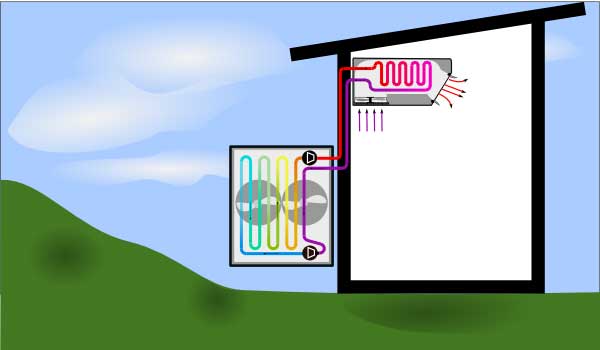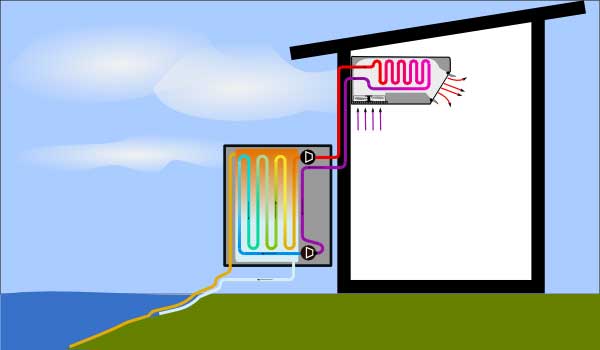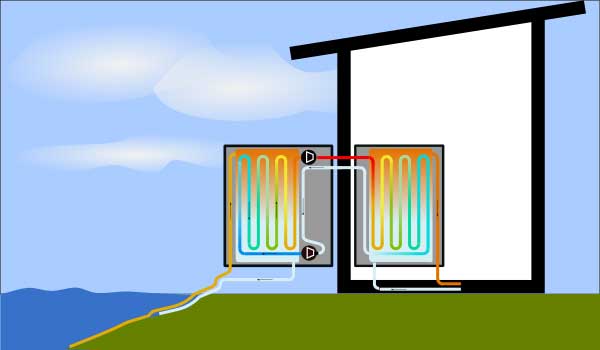Content – Energy distribution
What does a heat pump do
Heat pumps transport heat from a lower temperature level (a colder space) to a higher temperature level (a warmer space), hereof the term “pump” since the heat seemingly do not flow in its “normal” direction from warm to cold.
Heat pumps are used both for heating and for cooling purposes.
Transporting heat from the colder outdoor air to the warmer indoor air is an energy-efficient way to heat your home or any other space that needs heating.
The most common heat pump devices are; air heaters, water heaters, air conditioning units, refrigerators and freezers. The term “heat pump” is most often used to describe a heating device.
The most common types of heat pumps are:
Air to air heat pump (transporting heat from outdoor air to indoor air)

Water to air heat pump (transporting heat from a water source with stable temperature, to the indoor air. The water may be collected from the sea at water depths with stable temperature, from hot springs or by circulating water through deep bedrock wells).

Water to water heat pump (transporting heat from a water source with stable temperature to a water heater providing hot water for various heating purposes).

How heat pumps work
If two objects or mediums of different temperature are connected, heat will flow from the object with the higher temperature to the object with the lower temperature until thermal equilibrium (equal temperature).
A cooling medium is used to transport heat from the low temperature side to the high temperature side of the heat pump.
This is done through expansion and compression, transforming the cooling medium from gas to liquid and back to gas again, the result being that the cooling medium absorbs heat when it is expanded and have a low temperature, while it releases heat when compressed and having a higher temperature than the surroundings.
A certain amount of high-grade energy, such as electrical power is needed to run this process.
Typical heat pump function

The main stages and components of a heat pump:
- Evaporator – The evaporator is a heat exchanger located on the “cold side” of the heat pump, normally outdoor, that absorbs heat from the surroundings that is transferred into the cooling medium. The cooling medium at low pressure, low boiling point and at low temperature will when heat is absorbed boil and transform into vapour.
- Compressor – The compressor circulates the cooling medium through the various stages of the heat pump. When the cooling medium is compressed the pressure, boiling point and temperature is increased before entering the the condenser.
- Condenser – The condenser is a heat exchanger located on the “warm side” of the heat pump, normally indoor. that transfers heat to the surroundings. Since the temperature of the cooling medium and the inside of the condenser is higher than the temperature on the outside of the condenser and the surroundings, heat is transferred from the cooling medium to the surroundings, this again lowering the temperature of and condensing the cooling medium. The cooling medium now is in liquid form.
- Expansion valve – The cooling medium returns to the “cold side” of the heat pump through the expansion valve. During expansion the pressure, boiling point and the temperature of the cooling medium is lowered, the cooling medium now is a mixture of gas and liquid.
- Fan – An “air to air”, “air to water” and “water to air” heat pump needs to have fans to ensure air circulation and thereby proper heat exchange.
Other types of heat pumps works according to the same principles, however some of the components and the cooling medium may be slightly different, this includes air conditioning units, refrigerators and freezers.
Heat pump performance
Common performance criteria for heat pumps:
COP – Coefficient of Performance. Describes the relationship between power output and power input.
SCOP – Seasonal Coefficient of Performance. Describes the COP for a given heat pump over a full year of operation at given climate conditions. The higher the SCOP is for a heat pump the lower the annual power consumption will be at the given climate condition.
Power – The power (KW) actually delivered by a heat pump at a given temperature.
MOT – The lowest operational temperature guarantied by the heat pump manufacturer.
SEER – Seasonal Energy Efficiency Ratio. Describes the efficiency of the heat pump in cooling/air condition mode over a full year of operation at the given climate conditions.
Heat pump performance is measured by the amount of power needed to operate the heat pump (ie.to run the compressor, the fans and for defrosting) compared to the amount of power that is delivered from the heat pump. The Coefficient of Performance (COP) varies with type of heat pump, heat pump design, characteristics of the cooling medium and the temperature profiles of the “cold” and the “warm” side.
An air to air heat pump may have a COP (Coefficient of Performance) of 3-5 at “normal” conditions, meaning that the amount of power delivered is 3-5 times the electrical power consumed, whereas a common resistance heater, where all the heat is produced from the input power, would have a COP of around 1.
Heating performance:
Power into the warm space = Power from the cold side + Power applied
COP = Power into the warm space/Power applied
If COP = 4, it means that if 1 KW of electrical power is applied, 4 KW of heat is transported into the warm space.
The performance of a heat pump will decrease with increased temperature difference between the “cold” and the “warm” side of the heat pump.
The maximum theoretical efficiency of a heat pump may simplified be described by the following formula:
Theoretical efficiency for heat pump used for heating
COPmaxtheoretical=\dfrac{Tw}{Tw - Tc}
Theoretical efficiency for heat pump used for cooling
COPmaxtheoretical=\dfrac{Tc}{Tw - Tc}
where
all temperatures are in Kelvin (oK)
Tw = Temperature on the “warm” side. The warm side is the side the heat is transported to. This means that for heating purposes the “warm” side is indoor side. For cooling the “warm” side is outdoors or outside the space to be cooled down.
Tc = Temperature on the “cold” side. The cold side is the side heat is transported from.
Since actual COP for heat pumps is significantly less than the theoretical maximum COP, the theoretical COP do not have any practical use except, may be for demonstrating the effect of the temperature difference between the “warm” and the “cold” side.
An example:
Tw = 22 oC = 22 + 273,15 = 295,15 oK
Tc = 5 oC = 5 + 273,15 = 278,15 oK
COP maxtheoretical = 278,15/17= 16,4
If
Tc = – 10 oC = 273,15 – 10 = 263,15 oK
Then
COP maxtheoretical = 263,15/27 = 9,8
This demonstrates that by lowering the temperature of the “cold” side by 10 oC, the maximum theoretical COP is almost reduced by 50%.
The performances of an air-to-air heat pump will decreases when the outdoors air temperature is sinking. In addition to the direct negative effect on the COP at low outdoors temperatures, the negative effect will be strengthened since energy also will be consumed for defrosting the outdoor unit.
A modern heat pump designed for low temperatures can operate down to – 20 oC to – 30 oC, however a heat pump with COP of 4 at -2 oC will typically only have a COP of 2,25 at -10 oC.
A heat pump used for cooling, an air condition unit works the same way but the energy and heat distribution is somewhat different.
When the heat pump is used for heating purposes a large portion of the consumed energy will be transferred to, and exchanged as heat at the “warm side” via the compressor, while for the heat pump used for cooling purposes the heat generated by the consumed energy is more or less “wasted” since it will have to be transferred to, and exchanged at the “warm” side of the heat pump.
Climate conditions
Normally 3 different climate conditions are used to specify and describe heat pump capacities, those are:
Cold climate zone:
Use the average annual temperature spread for Helsinki as the template, giving the following key climate data:
Number of days used – 74% of total days, 269 days, 6446 hours
Average annual temperature – 5,3 oC
Average temperature during heat pump operation – 1,5 oC
Min/Max temperature – (-)22 oC/15 oC
Tempered climate zone:
Use the average annual temperature spread for Strasbourg as the template, giving the following key climate data:
Number of days used – 56% of total days, 205 days, 4910 hours
Average annual temperature – 10 oC
Average temperature during heat pump operation – 5,1 oC
Min/Max temperature – (-)10 oC/15 oC
Hot climate zone:
Use the average annual temperature spread for Athens as the template, giving the following key climate data:
Number of days used – 41% of total days, 150 days, 3590 hours
Average annual temperature – 18,5 oC
Average temperature during heat pump operation – 10,8 oC
Min/Max temperature – (-)2 oC/15 oC
Cooling/Air conditioning
The following climate data is used for cooling/air conditioning:
Number of days used – 30% of total days, 108 days, 2602 hours
Average temperature during heat pump operation – 23 oC
Min/Max temperature – 17 oC/39 oC
Heat pump data for selected heat pump models.
For a comprehensive data table please go to “Heat Pump data”
Heat pump data (small table)
COP - Coefficient of PerformanceMOT - The lowest operational temperature guarantied by the heat pump manufacturer.
(Data sources The Norwegian Consumer Council and heat pump manufacturers)
| Brand | Model | COP -2 oC | MOT (oC) |
|---|---|---|---|
| Panasonic | Heatcharge (VE 12) | 4.86 | -25 |
| LG | Nordic prestige PLUS 12 | 4.9 | -25 |
| Daikin | Ururu Sarara 35 | 5.57 | -20 |
| Toshiba | Dalseikal 8 35 | 4.85 | -25 |
| Mitsubishi Electric | MSZ-FH50VEHZ | 3.8 | -30 |
| General | ASHG14LTCB | 4.24 | -25 |
| Samsung | Smart Exclusive 12 | 5.1 | -25 |
| Fuji Electric | 14 LTCN | 4.24 | -30 |
| Bosch | EHP 6.5 AA | 4.7 | -20 |
| Fujitsu | Extreme 14 LTCB | 4.24 | -25 |